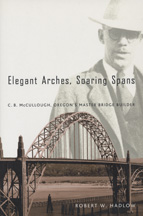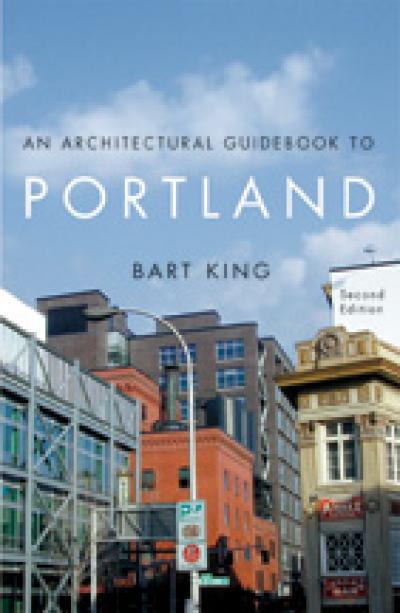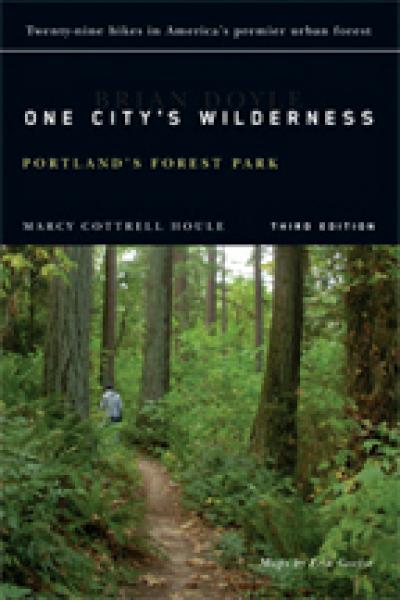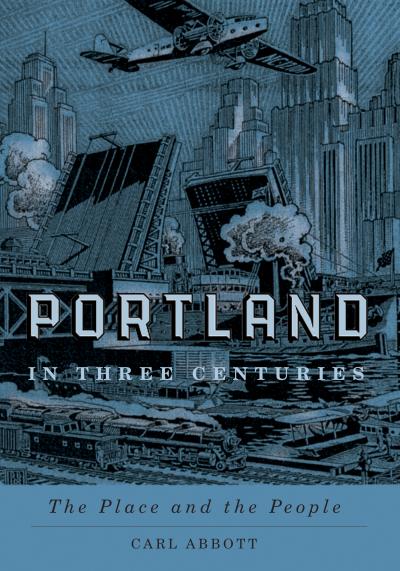
Elegant Arches, Soaring Spans
Robert W. Hadlow
Conde Balcom McCullough ranks as a modern bridge builder of national and international acclaim. This first major study of McCullough traces the Professional life of a brilliant engineer and builder renowned for his elegant, cost-efficient, custom-designed spans. McCullough's legacy lies in the nearly 600 bridges he and his staff designed and built in Oregon during the years between the two world wars, most notably several beautiful bridges along the Oregon Coast Highway, bridges he called "jeweled clasps in a wonderful string of pearls."
Trained as a civil engineer, McCullough came to Oregon in 1916, drawn by the state's dire need for bridges and its drive to "lift its feet out of the winter's mud and summer's dust." After developing the engineering program at Oregon Agricultural College (now Oregon State University), McCullough was named the state's bridge engineer. He became an impassioned promoter of state-sponsored bridge building that incorporated engineering efficiency with economic practicality and aesthetic appeal. McCullough's long career with the State Highway Department left a legacy of bridge building in Oregon unequaled in the twentieth century.
In 1999, Engineering News-Record recognized McCullough as one of the most important bridge engineers of the past 125 years. He was an innovator in twentieth-century reinforced-concrete arch construction and built one of the first concrete tied-arch bridges in the United States. McCullough's bridges are rich in aesthetic detail; the finest among them are embellished with arch crowns, Art Deco-inspired pylons and obelisks, Gothic piers, towering spires, and arched railing panels.
Illustrated with historic photographs and drawings, Robert Hadlow's definitive and highly readable biography will delight bridge buffs and engineering enthusiasts everywhere. It will also be of great interest to Oregon coast visitors and residents, and to students of transportation and technology history.
About the author
Robert W. Hadlow lives in Portland, Oregon, and has been a transportation historian for over a decade. His current project is a history of the design and construction of the Columbia River Highway. Hadlow received his Ph.D. in American History and Public History from Washington State University in 1993.
Read more about this author
List of Illustrations
Preface and Acknowledgments
- Introduction
- Civil Engineering With Anson Marston
- Building Bridges for Iowa, 1911-16
- Teaching at the Oregon Agricultural College and Early Bridge Building with the Oregon State Highway Department, 1916-24
- Achieving a Reputation for the State of Oregon, 1925-32
- The Coast Highway Bridges, 1933-35
- Central American and Beyond
- Conclusion
Epilogue
Appendix: Major McCullough Bridges
Notes
Glossary
Bibliography
Index
In 1937, when Conde B. McCullough was at the height of his career, a close friend asked him to describe his impressions of the engineer's role in society. McCullough replied, "From the dawn of civilization up to the present, engineers have been busily engaged in ruining this fair earth and taking all the romance out of it. They have cluttered up the landscape with hideous little buildings and ugly railroads." Modestly, McCullough hoped that his life work would bring back a small part of the romance lost.1
McCullough was one of a new breed of college-educated civil engineers. He was a pioneer in the movement to create a well-planned American highway system by researching road and bridge design from a scientific as well as practical perspective. Beginning in the early 1900s, McCullough argued that bridges should be built efficiently, economically, and attractively. He took his message to Oregon in the 1920s and 1930s and transformed the state's bridge building into a regional, national, and increasingly international showcase. The periodical ENR recognized McCullough in 1999 as one of the top ten bridge engineers among its list of engineering greats.
***
Iron Steel dominated American bridge building in the late nineteenth century. They were the materials of choice among numerous private companies that marketed their bridges to local governments. These "catalogue bridge entrepreneurs" promoted metal truss types that each claimed were superior to the products of their competitors. Large networks of salesmen from enterprises such as the Phoenix Bridge Company of Phoenixville, Pennsylvania, the King Bridge Company of Cleveland, and Andrew Carnegie's Keystone Bridge Company of Pittsburgh persuaded their clients with an expansive sales pitch rather than scientific fact. Bridges selected by county commissioners were supposed to provide years of service, but often did not. "The constant pressure to outsell and out produce competitors," David Plowden writes, led to shoddy practices, carelessness, and sometimes deliberate dishonesty."2
This system ended around the turn of the twentieth century for two reasons. First, railroad companies, and later state highway departments, required bridge companies to bid competitively on projects and college-trained engineers scrutinized their proposals. Second, reinforced concrete emerged as the preferred construction material for short-and-medium-length bridges.3
Many states had competent bridge engineering staffs, who usually created relatively short-span structures based on pedantic, unimaginative, pattern-book designs. But when larger and more elaborate structures were considered, states tended to contract with private consultants thought to be better suited for complicated technical designs. But stream crossings in the western states routinely required one-of-a-kind bridges. The highway bridge departments in these states, far from East Coast consulting firms, had to rely on the abilities of their own staffs. Many created standardized designs that were routinely modified for each project. While efficient and economical, these bridges lacked aesthetic qualities. In Oregon, state-sponsored bridge construction directed by Conde B. McCullough took a new and innovative direction with highway structures that were designed to blend with their natural settings.
McCullough designed efficient, economical, and elegant stream crossings. He was an original thinker with superior mathematical abilities, an eye for design, a great knowledge of bridge building worldwide, and efficient managerial skills. Like nineteenth-century engineering figures such as John Roebling and James Eads and their twentieth-century European counterparts Robert Maillart and Eugéne Freyssinet, McCullough combined an engineer's desire for creating efficient structures with public funds and an architect's drive for aesthetic excellence.4
***
From 1906 to 1910, McCullough studied civil engineering at Iowa State College under the respected and progressive educator Anson Marston. Marston trained his students in a curriculum that emphasized the applied aspects of the field as well as its philosophical underpinnings. Technical ability combined with well-rounded education, Marston believed, provided the foundation for creating sensible highway bridge designs for local, state, and national interests. Mccullough's training under Marston and Professor John E. Kirkham, a respected civil engineer, prepared him to become one of the nation's most accomplished bridge designers. He learned from his mentors that experts should give unselfish service to society.5
In 1910-11, McCullough worked for the Marsh Engineering Company of Des Moines, where he learned firsthand the intense rivalry among private companies to win bridge-building contracts from conty governments. James Marsh promoted his reinforced-concrete arch structures as superior to his competitors' designs, thereby influencing McCullough's future artistic ambitions.
From 1911 to 1916, McCullough worked for the Iowa State Highway Commission (ISHC) as its bridge engineer and assistant highway engineer. He was a member of a team of talented young college graduates serving under Thomas H. MacDonald, who later advanced to become chief of the U.S. Bureau of Public Roads (BPR), determining federal highway policy for nearly four decades. McCullough and his colleagues instituted a forward-thinking, efficient, and economical highway building program for Iowa, far advanced over the piecemeal, ineffective, and wasteful conty-based approach of the past.
McCullough had a good opportunity to hone his skills as a bridge designer while he worked at the ISHC. Because there was little professional literature, he devoted long hours to basic and applied research in structural challenges, hoping to find efficient and economical solutions to vexing engineering problems. He excelled in the mathematics involved in engineering calculations, and became known as an authority on bridge engineering when he offered expert testimony in court cases against unscrupulous bridge entrepreneurs. The expertise he gained helped him rise above his counterparts scattered across the country in other fledgling state highway departments and earned him widespread professional recognition.
With that national reputation, McCullough was invited to Oregon to teach structural engineering at Oregon Agricultural College (OAC), the state's land-grant school (now Oregon State University). He took an enthusiastic interest in the evolution, seeing certain parallels with his Iowa experience. Federal participation in nationwide road improvement emphasized establishing state highway programs with highly qualified staffs. Accordingly, in 1919, the Oregon State Highway Commission (OSHC) lured McCullough from OAC to become its bridge engineer. This marked the beginning of a solid career in building efficient, economical, and often beautiful bridges from a state agency base.
Progressive Oregon hired McCullough to help create an ordered system of highway bridges. Surrounding himself with bright assistants--his former students from OAC to his friends and classmates from Iowa--he formed a close-knit organization of professionals. As an extraordinary managerial wizard, McCullough excelled as the director of a bridge department, creating low-cost custom-designed structures characterized by architectural elegance. He preached that designers, in constructing long-lasting highway bridges, must take into account geological considerations, roadway alignments, traffic density, load requirements, and scenic value.
Reinforced concrete became McCullough's preferred medium over steel or wood. Some experts at that time viewed concrete as an expensive material requiring tedious mathematical calculations, but McCullough argued that lower maintenance expenses offset initial costs. He preferred the reinforced-concrete arch in large-span construction and he believed the arch cast in concrete was more economical than obvious alternatives. The reinforced-concrete arches in McCullough's larger bridges built from 1919 to 1936 combine aesthetics with efficiency and economy. His vision became a key component in transforming Oregon into a traveler's paradise that would generate state revenues through increased fuel taxes and stimulate local markets.
Throughout the 1920s and 1930s, McCullough became a prolific author of books and articles for engineering periodicals and bulletins for the BPR. He also studied law, and his interest in the convergence of law and engineering prompted him to earn a law degree. In the mid-1940s, he wrote a two-volume text on this subject.
Great challenges were McCullough's lifeblood. His large-span designs throughout the state, especially on the Oregon Coast Highway (U.S. 101), launched him into national and international prominence. The isaac Lee Patterson Bridge at Gold Beach (the Rogue River Bridge) was the first structure completed in the United States using French Engineer Eugéne Freyssinet's methods for reinforced-concrete arch rib precompression. McCullough's five large-span structures at Newport, Waldport, Florence, Reedsport, and North Bend on the Oregon Coast Highway together cost $5.6 million and represented the pinnacle of bridge design for their use of engineering advances and their architectural style to fit the natural setting. contemporary and subsequent critics saw them as masterpieces in design.
McCullough's accomplishments as Oregon's bridge engineer made him the BPR's logical choice to create several bridges for the Inter-American Highway. Between 1935 and 1937, he designed three short-span suspension bridges and a dozen other structures for the route through Panama, Honduras, Guatemala, and other Central American republics. When McCullough returned to Oregon in 1937, he promoted the suspension bridge as a realistic alternative to other design types because it fit well with his three-part design philosophy: economy, efficiency, and aesthetics.
Promoted to assistant state highway engineer in 1937, McCullough became an unwilling administrator removed from his preferred vocation. He turned his energy to researching highway department management questions and writing about engineering law.6
Many believe that, but for his untimely death in 1946, more spans with his signature elements might have been constructed. Nevertheless, McCullough had made his mark on Oregon; and most of the bridges for which he is best known are still an important part of the state's highway system. Employing technologies only developed in the past few decades to arrest and prevent degradation of steel and concrete construction, today's engineers are ensuring that McCullough's bridges will continue to be part of Oregon's landscape for decades to come.



